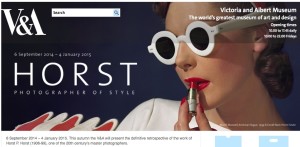Horst: Photographer of Style – V&A, London

Horst Bohrmann was born in Germany in 1906, travelled to Paris in 1906 where he studied architecture under Le Corbusier and moved in artistic and fashionable circles, and went from there to New York some years later. He collaborated with Vogue from 1931, and over time became one of their most regular photographers. In 1941 he took American citizenship (and also changed his name at this time), and became an army photographer – a much repeated fact about this time is that the next of kin on his dog tags was Edna Woolman Chase, Editor in Chief of Vogue. Horst had in fact by this point met his long-term partner Valentine Lawford, I both whom he adopted a son – they were together from 1938 until Lawford’s death in 1991.
Those, then, are the facts of Horst’s life. What of his work? The exhibition design is strongly geared towards a sense of glamour, which is what comes through most strongly in his work. Low lighting and dark walls set the mood for society models in beautiful gowns. Horst was apparently fastidious about lighting, and this is apparent in his work, in which light and shadow are used to full sculptural effect. Many of the labels accompanying the photographs include biographical information on the models, and quotes from the edition of Vogue in which they originally appeared, which helps to contextualise the fashion world in which Horst worked, seemingly so different than our own. Where the labels quote models on the experience of sitting for Horst, the comments are universally positive, and paint a picture of an exacting artist who remained a gentleman. Context, and visual interest, is also provided at the end of the first gallery, where a selection of gowns of the type seen in the images has been chosen from the V&A’s collections and displayed to great effect.
Glamorous black and white images of women in ballgowns were, however, not the only string to Horst’s bow. The exhibition also displays surrealist works, celebrity portraits, travel photography, kaleidoscopic ‘patterns from nature’, later colour fashion photographs, studies of interiors, and tasteful nudes, along with a small selection of shots from his time in the army. In terms of my own tastes and interests, I was particularly drawn to the travel photographs and patterns from nature. The former were taken during a trip from Tehran to Persepolis in 1949, and show equal care in representing ancient ruins and modern local tribes, and the latter were very unexpected in the context of the exhibition – close-up images of flora and fauna turned into expanding patterns. They were created for a book Horst published in 1946, and the exhibition shows his process of choosing, sketching and cropping the ‘patterns’ at his disposal.
Despite the range of techniques and interests shown, the contextualisation of quotes from magazines and sitters, and the looping footage at one point in the show of Horst at work, I didn’t come away from the exhibition feeling that I knew much about him. Maybe there were clues I missed, but I don’t remember seeing many images of the man himself after the initial context was set in the first room, and I don’t remember images of his partner or son. Besides the sketchbooks and annotated images seen throughout, I felt there was little connection with Horst: rather I was interpreting him through his work. There’s nothing to say that an exhibition can’t be about a body of work rather than the person behind it, but it did go away wanting to know a little more. The fact that his Wikipedia page is also rather sparse suggested to me at least that it may have been a deliberate separation between personal and professional lives. And none of this really takes away from the fact that I enjoyed the subject matter, content and design of what was a very well put together exhibition.
